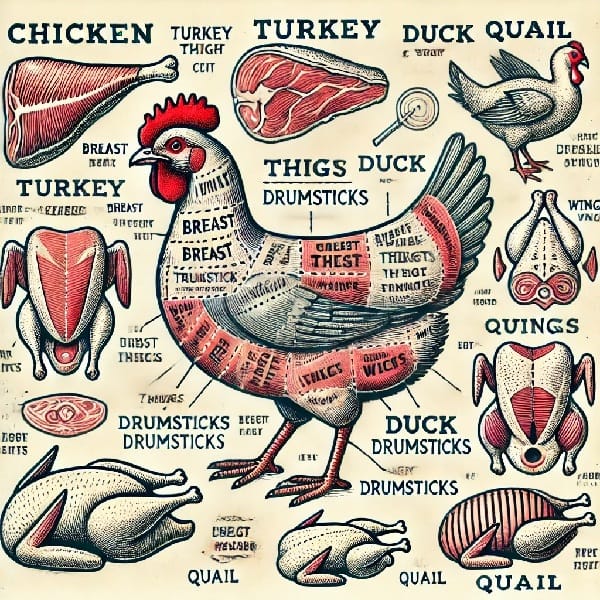Table of Contents
Chicken and Other Poultry: A Comprehensive Guide
1. Characteristics of Poultry
Poultry refers to domesticated birds raised for meat and eggs, including chickens, turkeys, ducks, geese, quail, pheasants, and guinea fowl. They vary in size, texture, and flavor.
- Chicken: Mild flavor, tender texture, highly versatile.
- Turkey: Leaner than chicken, slightly gamey flavor, firmer texture.
- Duck: Rich, fatty, flavorful meat with a firm texture.
- Goose: Highly fatty with a strong, deep flavor.
- Quail: Small, delicate, mildly gamey meat.
- Pheasant: Lean with a slightly stronger taste than chicken.
- Guinea Fowl: Tastes like a mix of chicken and game birds, lean and slightly gamey.
2. Texture and Flavor Profiles
- White Meat (Chicken, Turkey Breast, Quail Breast): Lean, tender, and mild-flavored.
- Dark Meat (Chicken Thighs, Duck, Goose, Turkey Legs): More fat, richer in taste, and juicier.
- Game Birds (Pheasant, Guinea Fowl, Quail): Slightly firmer and more flavorful due to their natural diets and activity levels.
3. Nutritional Value
Poultry is an excellent source of high-quality protein, vitamins, and minerals:
- Protein: Essential for muscle growth and repair.
- Vitamins: Rich in B vitamins (B6, B12, niacin), essential for metabolism.
- Minerals: Good source of iron, phosphorus, zinc, and selenium.
- Fat Content: Varies by species and cut; chicken breast is lean, while duck and goose have higher fat levels.
- Low in Carbohydrates: Poultry contains no carbs, making it a staple in low-carb diets.
4. Common Poultry Cuts and Butchery
- Whole Bird: Roasting, grilling, or braising.
- Breast: Boneless/skinless or bone-in; best for grilling, sautéing, and baking.
- Thighs: Juicy, flavorful; great for roasting, slow-cooking, and stews.
- Drumsticks: Best for grilling, frying, and braising.
- Wings: Popular for frying and barbecuing.
- Backs and Necks: Used for making stock and soups.
- Liver, Gizzards, Hearts: Often used in pâtés, gravies, and traditional dishes.

5. Storage and Shelf Life
- Refrigeration: Fresh poultry should be stored at or below 40°F (4°C) and used within 1-2 days.
- Freezing: Raw poultry can be frozen for up to 9-12 months (whole) or 6 months (cuts). Cooked poultry lasts 2-6 months in the freezer.
- Safe Handling: Avoid cross-contamination by keeping raw poultry separate from other foods.
6. Cooking Methods and Recipes
Cooking Methods
- Grilling: Imparts smoky flavor; best for chicken breasts, thighs, and wings.
- Roasting: Ideal for whole birds, resulting in crispy skin and juicy meat.
- Frying: Used for crispy wings, drumsticks, and fried chicken.
- Braising/Stewing: Great for thighs, drumsticks, and game birds; enhances tenderness.
- Poaching: Produces moist, tender chicken for salads and soups.
- Sous Vide: Ensures precise cooking with juicy results.
Popular Poultry Recipes
- Chicken Parmesan: Breaded chicken breast topped with marinara and cheese.
- Roast Turkey with Herbs: Traditional holiday dish with rosemary, thyme, and garlic.
- Peking Duck: Chinese dish with crispy skin and hoisin sauce.
- Coq au Vin: French braised chicken with red wine and mushrooms.
- Butter Chicken: Indian dish with spiced tomato-cream sauce.
- Peri-Peri Chicken: Spicy, marinated grilled chicken from Portugal/Africa.
- Buffalo Wings: Deep-fried wings tossed in spicy sauce.
7. Health Benefits of Poultry
- Heart Health: Lean poultry, like chicken and turkey, is lower in saturated fat compared to red meat.
- Muscle Building: High protein content supports muscle growth and recovery.
- Weight Management: Lean cuts are low in calories but highly satiating.
- Brain Function: B vitamins support neurological health.
- Immune Support: Zinc and selenium help boost immune function.
8. Global Poultry Industry Outlook
- Market Growth: Poultry is the world's most consumed meat, with increasing demand due to affordability and health benefits.
- Sustainability Trends: Growing focus on organic, free-range, and antibiotic-free poultry.
- Technology in Farming: Automation, AI, and precision farming are improving efficiency and sustainability.
- Rise of Alternative Proteins: Lab-grown and plant-based poultry alternatives are emerging.
- Key Producers: The U.S., China, Brazil, and the EU dominate global poultry production.









